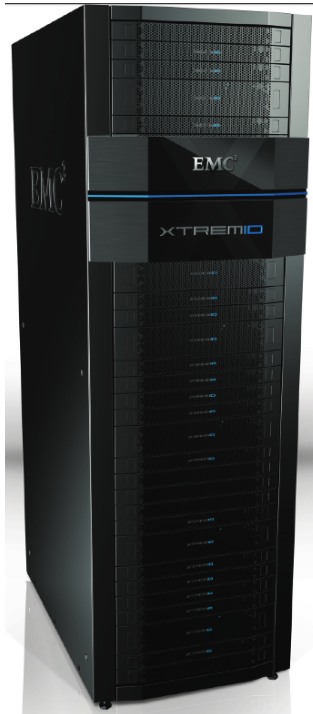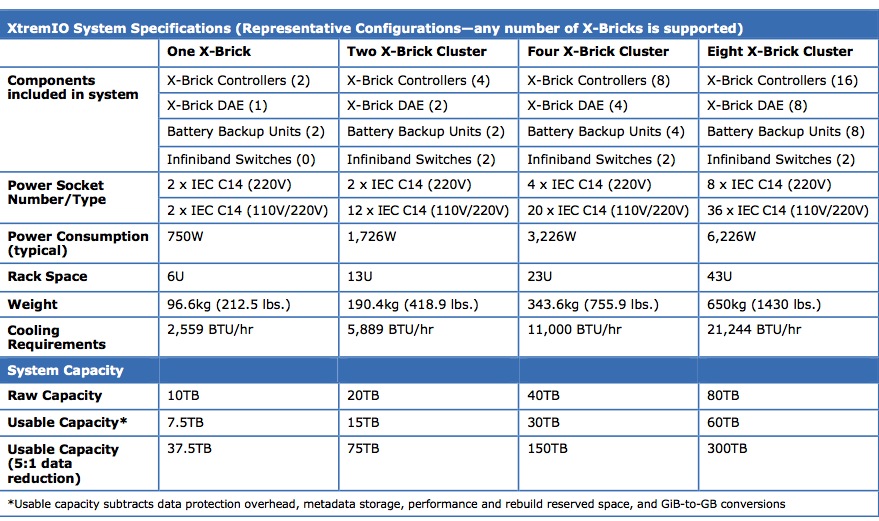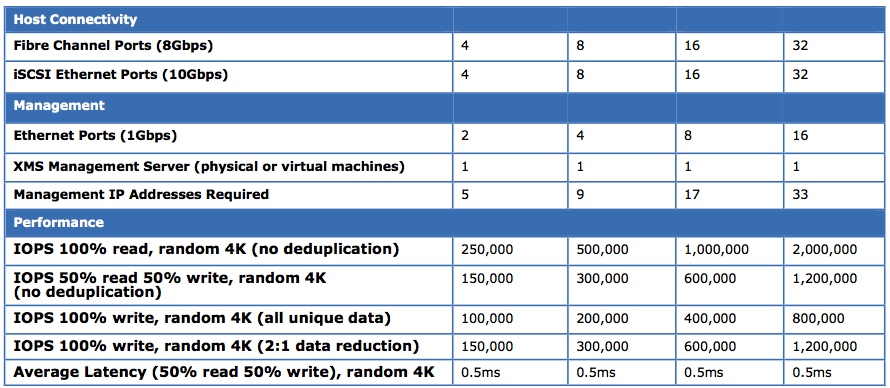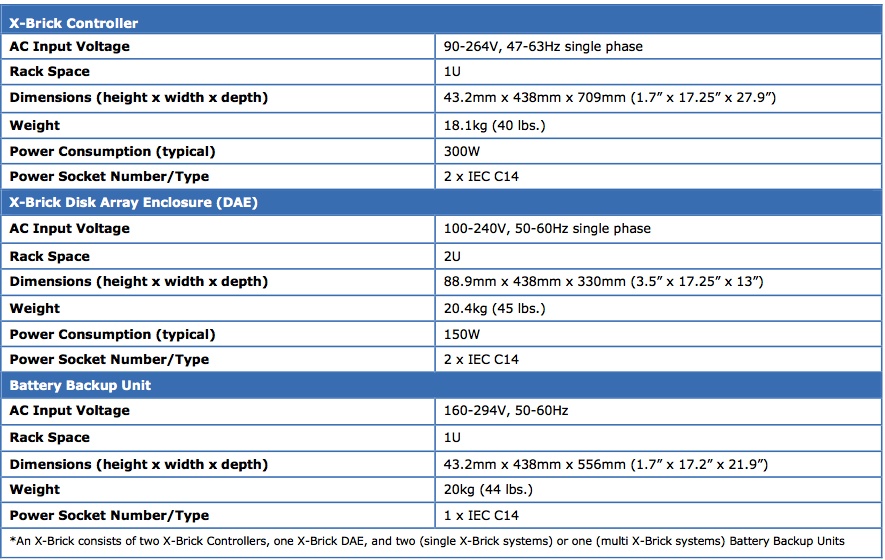EMC Finally Debuts Officially All-SSD XtremIO Subsystem
About all specs already known
This is a Press Release edited by StorageNewsletter.com on November 15, 2013 at 2:55 pmSummary:
- XtremIO is here. Extreme performance for any workload. With any array utilization. Over any period of time.
- XtremIO scales out. A unique multi-controller architecture designed for flash.
- Deduplication that is always on. Deduplication that is always inline.
- XtremIO reinvents RAID. 6X more efficient. 4X more performance.
- Better performance through better architecture.
- XtremIO is in demand. 10PB of effective capacity already sold.
EMC Corporation announced availability of its XtremIO, an all-flash array to provide consistent and predictable performance to any application workload over any period of time, regardless of whether the array is idle or busy, empty or full.
To achieve this, XtremIO features several flash innovations: a scale-out multi-controller architecture with linear scalability; deduplication that is always on, and always inline; data protection that is 6X more efficient and 4X faster than traditional RAID.
XtremIO is architected differently than any other all-flash array.
Four technologies work in concert to maximize performance without compromising efficiency or durability:
- Content-Based Data Placement
- Dual-Stage Metadata Engine
- XtremIO Data Protection (XDP)
- Shared In-Memory Metadata
EMC expects XtremIO to be a leader in the all-flash array market, which IDC forecasts to grow to $1.2 billion in revenue by 2015 (IDC Worldwide Enterprise All-Solid State Storage Array 2013-2016 Forecast, April 2013). The new array is already in demand, with 10PB of effective deduplicated capacity sold through EMC’s Directed Availability program (announced in March 2013).
XtremIO Technology Highlights
Customers are looking to all-flash arrays to support workloads that need predictable and consistent low-latency across datasets that frequently change – such as VDI, virtual servers, massively consolidated databases and test/development environments. These workloads not only achieve better performance, but also improved $/IO/s and administrative simplicity.
There are four key architectural differences that set XtremIO apart from other all-flash arrays:
- Content-Based Data Placement keeps the array inherently balanced and optimized to within a fraction of a percentage across all SSDs and array controllers and removes duplicate data inline in the data path.
- Dual-Stage Metadata Engine allows the array to leverage the random access nature of flash and place data anywhere in the array without requiring system level back-end cleaning processes (also known as garbage collection). This enables to avoid the up to a 50% performance hit in IO/s, up to 1,000% increase in latency, and up to 10X reduction in flash endurance compared to other flash arrays that use system level garbage collection.
- XtremIO Data Protection (XDP) is a flash-specific algorithm that guards against SSD failures while delivering up to 6X more usable capacity than traditional RAID. XDP allows end-users to utilize 100% of the capacity on XtremIO – while maintaining maximum levels of performance. Other all-flash arrays will begin to show degraded performance when they reach 60% to 80% of capacity. This means that XDP delivers up to 40% more usable capacity compared to other all-flash arrays. In addition, the efficient XDP algorithms deliver up to 4X better performance and flash endurance than RAID in long-term production data center conditions.
- Shared In-Memory Metadata enables the array to deliver a range of performance, and to rapidly clone information already in the array to massively accelerate common tasks like deploying VMs. VM clones are created at up to 20X the network bandwidth between the host and the array, several times faster and with lower impact to production VMs than other all-flash arrays.
XtremIO is a scale-out array based on building blocks called X-Bricks. Each one is available with 10TB of capacity – with an additional option for 20TB of capacity expected to be available early next year. Arrays deliver up to one million random IO/s with over 250TB of effective capacity in a single cluster with inline deduplication. A single cluster scales from two to eight controllers and up to 128 cores, capable of handling any OLTP Database, virtual server and VDI workload – with all data services active.
In addition, XtremIO is integrated within the EMC ecosystem to provide additional capabilities, ease-of-use, and compatibility. A VCE Vblock Specialized System for Extreme Applications based on XtremIO all-flash arrays provides VDI end-user computing performance at unprecedented cost per virtual desktop, which customers can begin ordering by the end of 2013. XtremIO array management is also integrated with vSphere and accelerated with VMware’s VAAI storage APIs. In addition, XtremIO is supported with other EMC technologies including EMC VPLEX, EMC PowerPath and EMC Secure Remote Support (ESRS).
Brian Dougherty, chief technical architect, CMA Consulting Services, said: “CMA is a leader in building very large scale technical platforms for healthcare applications. Our multi-tenant Oracle RAC environment generates a mixture of large sequential and random IO workloads simultaneously. We needed a specialized weapon that could handle the large mixed random and sequential workloads, while never degrading performance. We also needed a solution that was simple to manage and configure – configuring 10’s of terabytes of storage in a matter of minutes versus hours – with protection. We chose XtremIO because it delivers better performance, is simple to manage and configure and lowers our TCO. It stood far apart from other solutions and reset our expectations for what we can do as an IT organization in our Oracle RAC environment.”
Russ Norman, senior manager of systems engineering, E*TRADE Financial Corp., said: “Performance, reliability, and speed are critical in our application environments. We require an infrastructure that provides very low latency, allowing orders to be processed quickly. We are deploying XtremIO to get us to the next level of performance – but even more than that provide us with new levels of usability for our applications. With these lower storage latencies, we can process higher numbers of IO/s and move larger amounts of data. We found on average writing to the XtremIO array to be between 0.25 to 0.3 millisecond response time, with reads being somewhere around 0.2 millisecond. This was, consistent with workloads between 100,000 to 200,000IO/s. In addition, XtremIO’s thin provisioning and inline deduplication were selling points for us also for cost and capacity efficiency.”
Todd Pavone, EVP, product development and strategy, VCE, said: “The Vblock Specialized System for Extreme Applications with EMC XtremIO all flash-based arrays delivers exceptional performance for scalable, data-intensive VDI solutions such as VMware Horizon View and Citrix XenDesktop. VCE’s best-of-breed converged infrastructure provides customers with rapid response times, unmatched ease of use and, best of all, proven scalability for up to hundreds of thousands of virtual desktops at an incredible price point.”
Erik Frieberg, VP, product marketing, end-user computing, VMware, Inc., said: “XtremIO provides flash memory performance for unique and demanding workload requirements found in VDI environments. XtremIO all-flash arrays with VMware Horizon View will enable our joint customers to achieve high performance and efficiency, with the ability to lower costs.”
Laura Dubois, research VP of storage, IDC, said: “What I find most compelling about XtremIO is the unique architecture. Core functions such as granular metadata processing, shared in-memory metadata handling and content-based data placement are enablers to XtremIO’s impressive sustained IO/s metrics while offering core services – including deduplication and copy data services. There are other all-flash arrays with impressive performance metrics – but not for a sustained basis. The other standout capabilities with this system are native inline deduplication, in-memory metadata only copy and a scale-out architecture. These are attributes not all of the ‘all-flash array’ solutions on the market offer.”
CJ Desai, president, emerging technology products division, EMC, said: “Flash continues to be a major disruptive force – and an incredible market opportunity in storage. There is an insatiable appetite for performance driven by next generation data center workloads in both physical and virtual environments. EMC’s strategy is to leverage flash technology across the entire storage infrastructure with a best-of-breed product portfolio that allows us to deliver customers choice. With XtremIO, we’re delivering this fast growing market with a specialized solution that delivers ‘more’ – more consistent and predictable performance, more scale, more integration and more data services. And most importantly, we’re doing this on a fundamentally better architecture, which will allow us to easily deliver even more value-added features over time.”
Comments
About all the specs of the first all-SSD XtremIO were known before this official announcements, 18 months after EMC acquired Israeli start-up XtremIO. Read also: EMC/XtremIO Fail to Impress Blogged CEO Tom Isakovich, Nimbus Data You’re Going to Hear a Lot Next Year From This Product – CORRECTED All-SSD system from EMC/XtremIO with integrated de-dupe EMC Acquires XtremIO Confirmation EMC Close to Buying XtremIO, in Enterprise SSD-Based Systems For $400 to $450 million Start-Up’s (Small) Profile: XtremIO In enterprise SSD-based systems The product is late. In a controversial interview in November 2012 with Chuck Hollis, at this time global marketing CTO, EMC, he said "You'll see all-flash array in first half of 2013 as general product." Now the competition is really engaged in these subsystems with the arrival if of EMC, the number one storage company in the world, against the 33 others small and big companies already marketing all-flash devices, some of them having products comparable to XtremIO. Here are the "nice"comments of two storage competitors, IBM and XIO. IBM The most glaring difference between the XtremIO and IBM FlashSystem is that the XtremIO systems are based on SSDs, which perform slower than NAND eMLC flash that's directly attached to the system board - which the FlashSystem features. But just as important as the technology, are the strategic differences between EMC and IBM. Through the Smarter Storage strategy, IBM works with customers to understand their specific workload issues - first - and then apply the most effective storage technologies to the challenge. A great example of this strategy can be seen in MSP, Cegeka, of Belgium. The company uses FlashSystems to speed the performance of its SAP apps via the cloud, and XIV for high end disk and storage management. It also uses SVC virtualization software to quickly add systems and scale the infrastructure.
| IBM FlashSystem | EMC XtremIO |
| 20TB, 1U | 7TB, 6U |
| 110?s latency (5x faster) | 500?s latency |
| 500K IO/s | 250K IO/s |
| Native eMLC | eMLC SSDs |
| 400W power | 750W power |
- SSD - SSDs place flash memory on a small circuit board and then into a physical disk drive enclosure that fits in a drive array chassis; it then connects to a SAS backplane via a SAS interface. SAS adds latency, slowing data access. (XtremIO = SSD)
- Native Flash - eMLC NAND all-flash systems place hardware-accelerated flash memory modules directly onto the system motherboard, which has lower latency (10x faster) and higher throughput than a SAS interface. (FlashSystem = native flash)
- Reliability - XtremIO commodity eMLC SSDs lack the data protection levels provided by FlashSystem. In addition, FlashSystem includes IBM patented Variable Stripe RAID that enables FlashSystem to survive failures that will force XtremIO SSDs to be replaced.

















 Subscribe to our free daily newsletter
Subscribe to our free daily newsletter

